The Seagate 600 & 600 Pro SSD Review
by Anand Lal Shimpi on May 7, 2013 8:00 AM ESTRandom Read/Write Speed
The four corners of SSD performance are as follows: random read, random write, sequential read and sequential write speed. Random accesses are generally small in size, while sequential accesses tend to be larger and thus we have the four Iometer tests we use in all of our reviews.
Our first test writes 4KB in a completely random pattern over an 8GB space of the drive to simulate the sort of random access that you'd see on an OS drive (even this is more stressful than a normal desktop user would see). I perform three concurrent IOs and run the test for 3 minutes. The results reported are in average MB/s over the entire time. We use both standard pseudo randomly generated data for each write as well as fully random data to show you both the maximum and minimum performance offered by SandForce based drives in these tests. The average performance of SF drives will likely be somewhere in between the two values for each drive you see in the graphs. For an understanding of why this matters, read our original SandForce article.
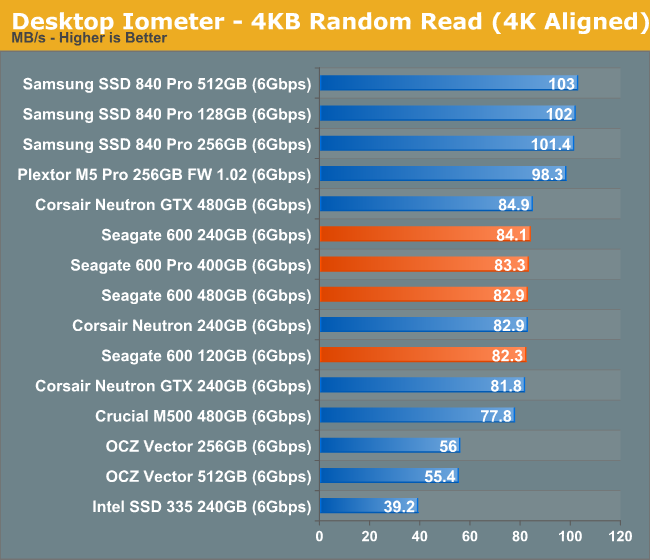
Random read performance is consistent across all capacity points. Performance here isn't as high as what Samsung is capable of achieving but it is very good.
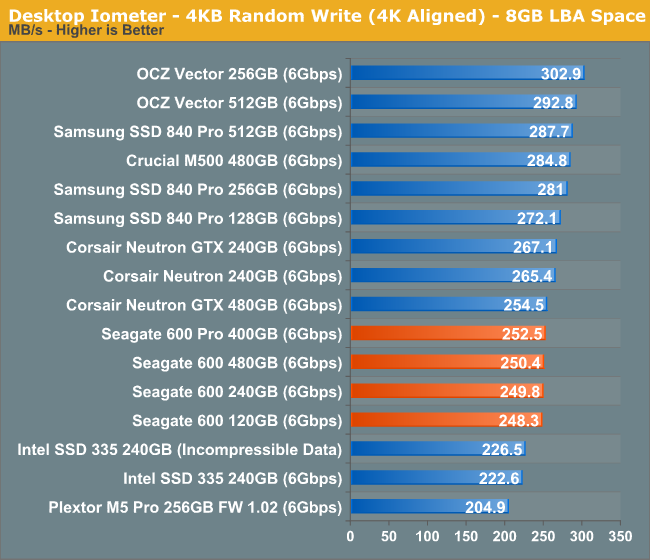
Low queue depth random write performance has just gotten insanely high on client drives over the past couple of years. Seagate doesn't lead the pack with the 600 but it does good enough. Note the lack of any real difference between the capacities in terms of performance.
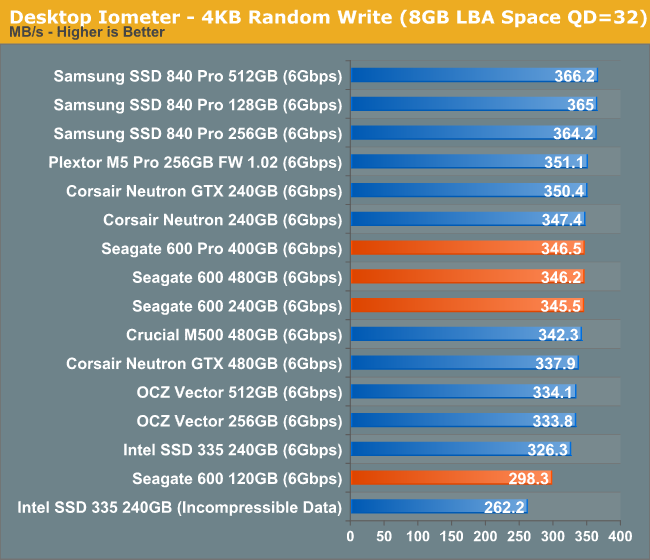
Ramp up queue depth and we see a small gap between the 120GB capacity and the rest. The 600/600 Pro climb the charts a bit at higher queue depths. Note the lack of any performance difference between the 600 and 600 Pro at similar capacities.
Sequential Read/Write Speed
To measure sequential performance I ran a 1 minute long 128KB sequential test over the entire span of the drive at a queue depth of 1. The results reported are in average MB/s over the entire test length.
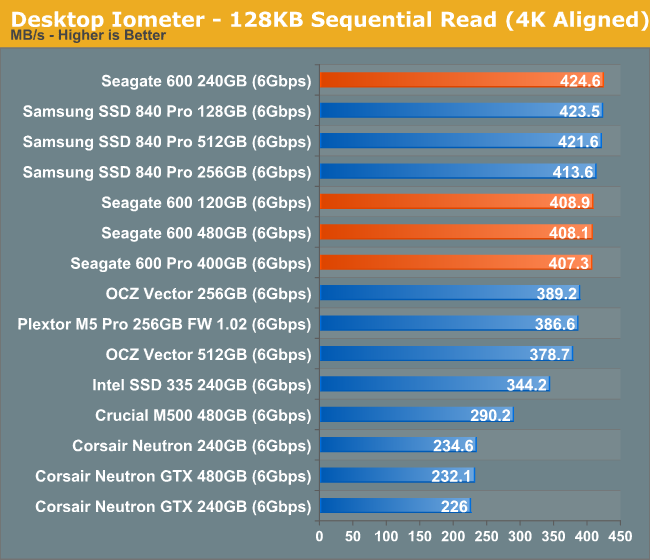
Here's how you tell that Seagate has client drive experience: incredible low queue depth sequential read performance. I'm not sure why the 240GB 600 does so well here, but for the most part all of the drives are clustered around the same values.
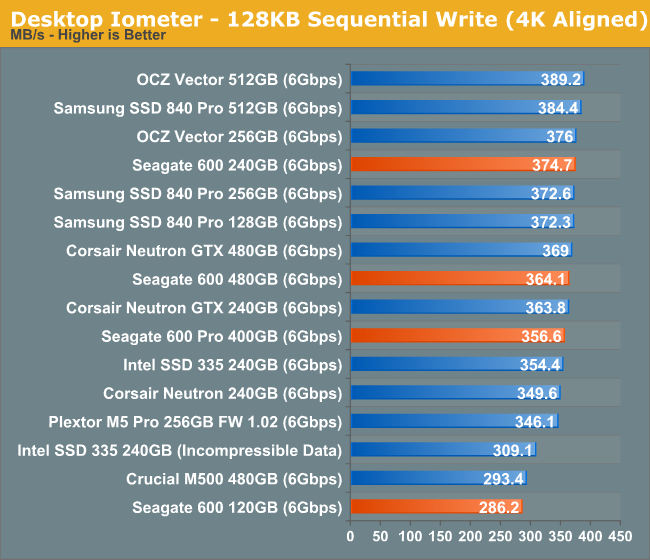
Low queue depth sequential writes are also good. The 240GB capacity does better than the rest for some reason. Only the 120GB capacity shows any sign of weakness compared to other class leaders.
AS-SSD Incompressible Sequential Read/Write Performance
The AS-SSD sequential benchmark uses incompressible data for all of its transfers. The result is a pretty big reduction in sequential write speed on SandForce based controllers.

On the read side, at high queue depths we're pretty much saturating 6Gbps SATA at this point. The fastest drive here only holds a 3% advantage over the 600s.
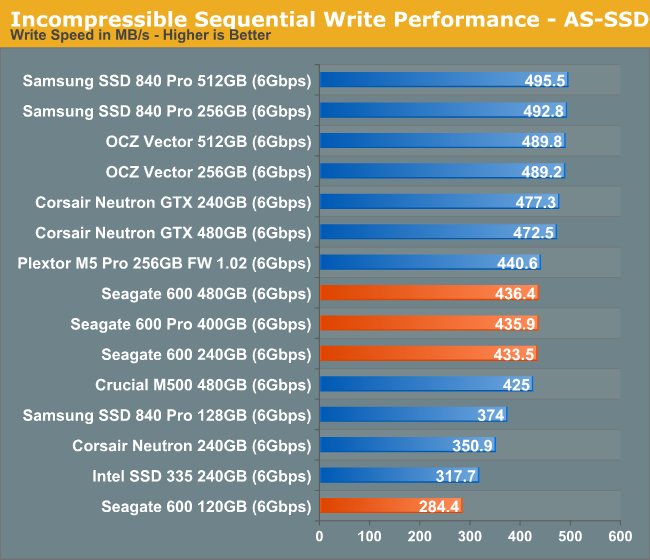
Once again we see solid performance from the 600s. There's no performance advantage to the Pro, and the 120GB capacity is measurably slower.










59 Comments
View All Comments
numberoneoppa - Tuesday, May 7, 2013 - link
It's too bad about the idle power consumption, but if the prices are decent, I might pick up a higher capacity variant to replace my 80GB m25 G2 in my desktop.ssj3gohan - Tuesday, May 7, 2013 - link
I don't think Anandtech has implemented their improved (DIPM-enabled) power consumption tests yet, so the idle figures here are pretty much meaningless. When it comes to market, check the datasheet for actual idle power consumption.Kristian Vättö - Tuesday, May 7, 2013 - link
Seagate's datasheet shows average idle power of 1.1W: http://images.anandtech.com/doci/6935/Screen%20Sho...lightsout565 - Wednesday, May 8, 2013 - link
Does anyone know how power consumption compares to the 128GB Samsung 830? In Anand's review of the 830 he mentions, "Samsung sampled the 512GB version of the SSD 830 so it's unclear how much the sheer number of NAND die impacts power consumption here." During the test of the 513GB version, it showed 1.22W at idle.Kristian Vättö - Wednesday, May 8, 2013 - link
The 128GB SSD 830 idles at 0.38W (I think the firmware is also newer, the 512GB had pre-production FW as far as I know). As always, you can find all our SSDs (and other components) in the Bench, here's the 128GB SSD 830:http://www.anandtech.com/bench/Product/533
cactusdog - Tuesday, May 7, 2013 - link
I don't understand why Seagate and WD were so slow in the SSD market. They should have a complete range of SSDs by now. They could have just rebranded OEM drives (if they didn't want to spend money) and would have sold millions just from their name alone. Like Kingston and others did...... I don't get it.Sabresiberian - Tuesday, May 7, 2013 - link
I wonder if the main HD manufacturers here were doing a bit of "American auto industry" thinking. Like "We sold all the gas guzzlers we could make before, how are we supposed to know the general population is going to want cars that get better gas mileage?" Chrysler and GM had to be bailed out twice for that kind of thinking.So, were Seagate and Western Digital thinking "We're selling all the HDs we can make, why should we get into SSDs?" I don't know, but it's an explanation that seems to fit, to my way of thinking anyway.
Powerlurker - Tuesday, May 7, 2013 - link
I think it's more that Seagate and WD have extensive expertise in manufacturing HDDs that can't be replicated by competitors and lots of industrial infrastructure that only they (and Toshiba at this point) have. Meanwhile, on the SSD front, they would be competing with any idiot on the Pacific Rim with a reference design and a pick-and-place line. SSDs are rapidly becoming commodity products at the consumer level and long term profitability in the segment requires you to have your own special sauce (controller technology, firmware expertise, a NAND fab, or some other unique advantage) which WD and Seagate don't really have at this point.Kristian Vättö - Tuesday, May 7, 2013 - link
While WD and Seagate lack the SSD expertise, they have the distribution channels and resources. Hynix is a good example of a company that has all the expertise they need to develop a competitive SSD but their distribution channel is lacking. Seagate, on the other hand, operates globally and can reach billions of potential buyers in a short period of time. Even if you have a good product, it's fairly meaningless if it can't reach most of the market. Hynix actually makes SSDs but they are doing absolutely nothing to market them and I bet they don't have many distributors in the US or other Western countries (NewEgg sells their SSDs but I haven't seen them elsewhere).Seagate also has tons of capital to invest on the SSD market. Like in the case of this SSD, they didn't just go with stock SandForce but chose LAMD and invested on specializing the firmware. On top of that, I'm pretty sure Seagate has fairly big NAND deals with Toshiba and Samsung to ensure a steady supply of NAND, which requires capital. There have already been NAND shortages in the market and this year it will get even tougher - Seagate has an advantage because they can buy a ton of NAND whereas smaller players lack the capital for that (and the bigger client you are, the more important you are for the company so big clients are prioritized when there's a shortage).
What would be a killer combination in the future is Seagate and Hynix combining their powers.
secretAgent! - Tuesday, May 7, 2013 - link
WD is coming out soon with SSD PCIe cards soon.... i've helped test them.... shhhh....